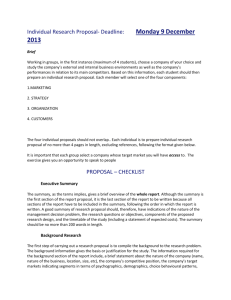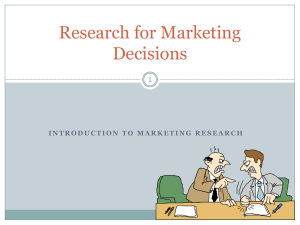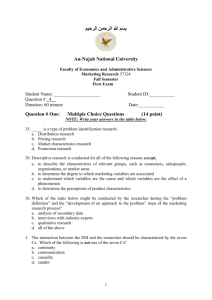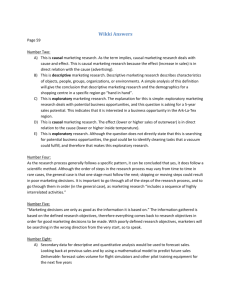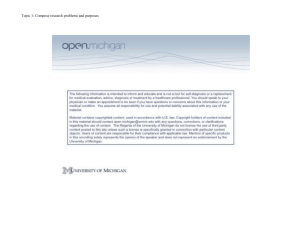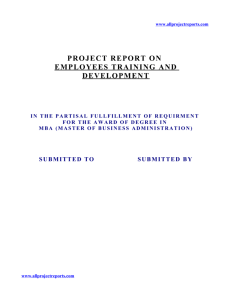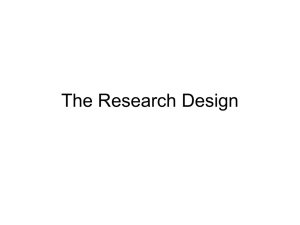transcript - NMSU College of Business
advertisement
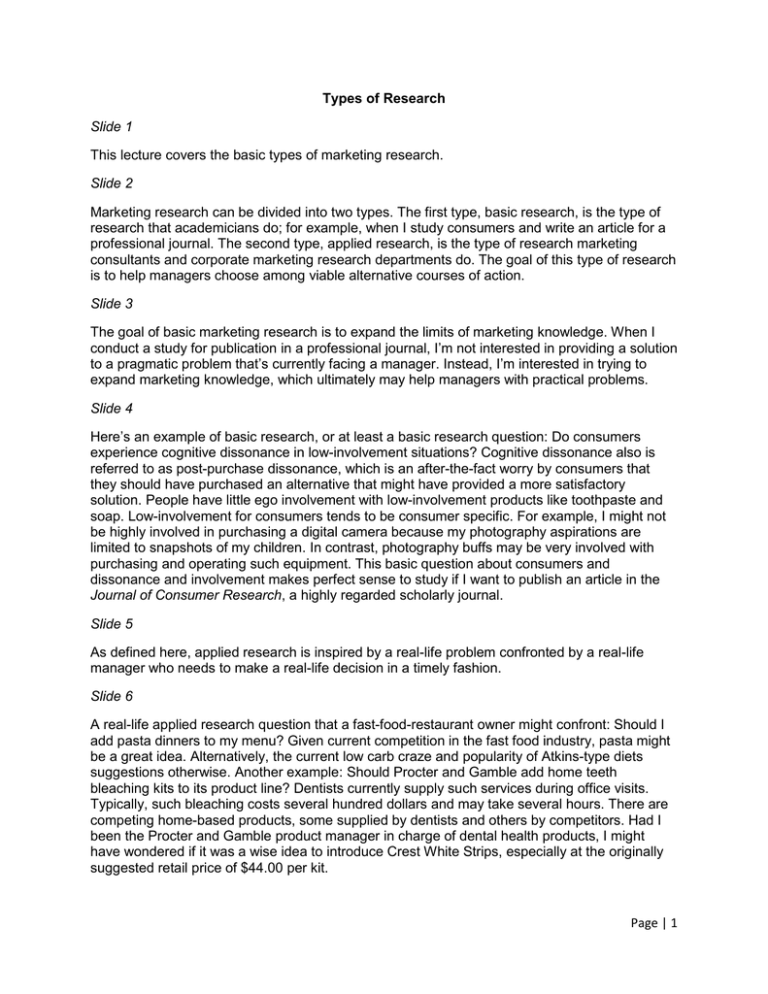
Types of Research Slide 1 This lecture covers the basic types of marketing research. Slide 2 Marketing research can be divided into two types. The first type, basic research, is the type of research that academicians do; for example, when I study consumers and write an article for a professional journal. The second type, applied research, is the type of research marketing consultants and corporate marketing research departments do. The goal of this type of research is to help managers choose among viable alternative courses of action. Slide 3 The goal of basic marketing research is to expand the limits of marketing knowledge. When I conduct a study for publication in a professional journal, I’m not interested in providing a solution to a pragmatic problem that’s currently facing a manager. Instead, I’m interested in trying to expand marketing knowledge, which ultimately may help managers with practical problems. Slide 4 Here’s an example of basic research, or at least a basic research question: Do consumers experience cognitive dissonance in low-involvement situations? Cognitive dissonance also is referred to as post-purchase dissonance, which is an after-the-fact worry by consumers that they should have purchased an alternative that might have provided a more satisfactory solution. People have little ego involvement with low-involvement products like toothpaste and soap. Low-involvement for consumers tends to be consumer specific. For example, I might not be highly involved in purchasing a digital camera because my photography aspirations are limited to snapshots of my children. In contrast, photography buffs may be very involved with purchasing and operating such equipment. This basic question about consumers and dissonance and involvement makes perfect sense to study if I want to publish an article in the Journal of Consumer Research, a highly regarded scholarly journal. Slide 5 As defined here, applied research is inspired by a real-life problem confronted by a real-life manager who needs to make a real-life decision in a timely fashion. Slide 6 A real-life applied research question that a fast-food-restaurant owner might confront: Should I add pasta dinners to my menu? Given current competition in the fast food industry, pasta might be a great idea. Alternatively, the current low carb craze and popularity of Atkins-type diets suggestions otherwise. Another example: Should Procter and Gamble add home teeth bleaching kits to its product line? Dentists currently supply such services during office visits. Typically, such bleaching costs several hundred dollars and may take several hours. There are competing home-based products, some supplied by dentists and others by competitors. Had I been the Procter and Gamble product manager in charge of dental health products, I might have wondered if it was a wise idea to introduce Crest White Strips, especially at the originally suggested retail price of $44.00 per kit. Page | 1 Slide 7 Whether we’re considering basic research or applied research, many of the same marketing research methods can be applied. For surveys, experiments, secondary data, observation, or qualitative research, it’s never that some methods are appropriate to one type of research but inappropriate for another type. The application of these methods strictly depends on the problem at hand, rather than if it’s a basic research problem or an applied research problem. Slide 8 In marketing research, as in other types of research, we talk about three basic types: (1) exploratory research, which includes qualitative research, depth interviews, and observations; (2) descriptive research, which predominantly is survey-based research; and (3) causal research, which predominantly relies on experiments to establish cause-and-effect relationships. With exploratory research, we’re trying to understand the research environment a bit better, with the goal of helping us design better descriptive studies. With descriptive research, we’re trying to describe the environment; we’re merely examining whether the characteristics of things or phenomena tend to be associated with one another; for example, if males are more likely than females to purchase a certain product or if the predominant purchaser of a certain product is younger or older. All three types of research constitute separate and substantial topics in this course. Slide 9 Exploratory research often—but not always—is preliminary to conclusive research. Descriptive and causal research fall under the heading of conclusive research. Such research is meant to provide managers with sufficient evidence for making more informed decisions. Descriptive research is more survey based and causal research is more experiment based. Descriptive research may rely on cross-sectional and longitudinal designs. Slide 10 Whether causal, descriptive, or exploratory research is conducted depends on the level of uncertainty about the research environment. If you’re very uncertain about the research problem and research questions, or if you’re unaware of the ways that your customers think about your product or the language they use to describe it, then exploratory research can help to reduce your uncertainty. Alternatively, if your research problem and research questions already are well understood, then a survey of reasonable quality could be designed and fielded. Once you’ve conducted enough descriptive research to get a good sense for possible cause-and-effect relationships, then you might want to conduct an experiment to test those relationships. For example, you might want to determine how much your sales would increase if you increased your advertising budget by $1 million. The bottom line: Whether you do exploratory research or more conclusive research depends on your understanding of the research problem and related research questions. Slide 11 Here’s a cartoon that illustrates the kinds of questions managers have about research they may order. When the manager—the guy with his feet on the desk—asks the question “Why did our sales sag?” he doesn’t understand the possible causes; if so, then exploratory research is warranted to help identify possible causes. If the manager’s research question is “How many people in town are aware that we sponsor a sports team?” or “Who are the heavy user segments in his market?” then research that describes the market is needed. Well-conceived Page | 2 survey research should help to answer such questions. If the manager’s question is about the possible efficacy of a new ad theme, then a cause-and-effect relationship should be established through an experiment. Finally, if the manager is interested in forecasting next year’s sales, then he needs predictive research. Predictive research isn’t one of the basic types—like exploratory, descriptive, and causal—but it indicates a type of research problem experienced by managers. Hence, this cartoon illustrates the different kinds of research questions that managers face. Slide 12 Here’s a figure to help you understand the different kinds of research approaches. There are different types of problems that a manager might confront. In exploratory research, the manager is basically unaware of the true nature of the problem. He or she might ask questions about sales declining and be totally unaware of the cause, or ask questions about possible consumer segments that might be interested in the purchase of a new product. If the manager is aware of the problem, then descriptive research is a more sensible approach. Some questions that lend themselves to descriptive research: Who tends to buy our product? Who are our competitors? What features do buyers prefer in our product? Finally, if the problem is clearly defined, then causal research is appropriate. The questions you see here are “Will buyers buy more of our product in a new package format?” or “Which of two advertising campaigns are more effective?” These types of research problems lend themselves to experimental designs. We could test two alternative ad campaigns with samples of different respondents to get some sense of which campaign might be more effective. Slide 13 Here’s another exhibit to help you understand how research problems, which here is referred to research purpose, relate to a set of research questions and ultimately a set of hypotheses to be tested formally. Slide 14 At this point, I’ll talk a bit more in depth about the basic types of research: exploratory, descriptive, and causal. Slide 15 As this slide indicates, exploratory research is intended as initial research and is conducted to clarify and define the nature of a marketing research problem. Exploratory research is not intended to provide conclusive evidence upon which managers base their decisions. The assumption of any researcher conducting exploratory research is that subsequent, more conclusive evidence, will be provided by subsequent research. This is one of the major problems managers have with focus groups. Focus groups are a type of exploratory research that I’ll discuss in more depth in subsequent lectures. Some managers who order focus groups erroneously believe these groups provide some grand sense about consumers’ thoughts and expectations, so they mistakenly fail to order the additional research that’s needed. Slide 16 Here are two of the many types of exploratory research. Secondary or historical data is considered a type of exploratory research. Given the growing prevalence of the internet, this may be the dominant kind of research you’re involved with during the next thirty to forty years. Secondary data is previously collected data. For example, the U.S. Government, with the Census, collects what we refer to as secondary data that might help you to make better Page | 3 marketing decisions. Both the business literature targeted at academicians and the literature targeted at practitioners may provide meaningful insight into the directions that managers may choose to take their companies. Another type of exploratory research is called a pilot study. As you might suspect, a pilot study is a small-scale study meant to give both managers and researchers a better sense for a larger full study they might run subsequently. Slide 17 The name descriptive research is very indicative of this type of research. Descriptive research is intended to describe the characteristics of a population or a phenomenon. A population could be potential customers for your product. A phenomenon could be the shifting economic reality, nationally or globally. The point of descriptive research is to provide some, although not absolute, understanding about the nature of a problem. Slide 18 Here’s an example of what a marketing researcher might discover about the average Weight Watchers customer. Doing a survey of Weight Watchers customers might indicate that the typical customer is a woman who’s roughly 40 years old, with a household income of roughly $50,000, who’s had at least some college education if not a college degree, and who’s trying to juggle the demands of children and a job. Knowing that Weight Watchers’ typical customer had a profile like this one would help Weight Watchers’ managers to more effectively modify and target their products to the group interested in purchasing their meals and services. Slide 19 Here’s another example of what a researcher might discover by doing a descriptive study. In this case, it’s the men’s fragrance market. If we were to look at secondary data, we might discover this market is only 1/3 the size of the women’s fragrance market. We assume by 1/3 the size here, we’re talking about dollar volume, but it may be unit sales. We would discover that this market, although smaller than the women’s market, is growing at a significantly faster pace, so sales growth over time might suggest whether or not it’s worthwhile to pursue this market. Perhaps the most interesting thing, from a marketing perspective, is that women buy 80% of the fragrances intended for men. If we think in terms of designing and targeting advertising, even if it’s for men’s fragrances, we’d want to target women because they’re typically purchasers, but not the consumers, of men’s fragrances. Slide 20 As the name clearly implies, causal research is intended to identify cause-and-effect relationships. If we do X, then will the result be Y? That’s what we’re trying to determine out when we’re trying to establish the existence of a cause-and-effect relationship. Slide 21 It’s impossible to prove definitively that a cause-and-effect relationship exists because alternative explanations for a phenomenon may be true. Even though we may try in an experiment to control for all the external explanations, it’s impossible to do so. However, for the purposes of understanding what we hope to establish, when we’re trying to provide evidence of causality, the three conditions listed here are critical. Page | 4 Condition #1: An appropriate causal ordering of events. Event A always must precede Event B. If Event B ever precedes Event A, then Event A is not the only possible cause of Event B. Thus, ordering is important. Condition #2: Concomitant variation, which means when A and B always vary together. When A goes up, then B goes up, and when A goes down, then B goes down, is an example of direct variation. If A goes up when B goes down and vice versa, then there’s an inverse relationship between A and B. Condition #3: Eliminate all alternatives and explanations for A seeming to cause B, as opposed to C causing B, or D causing B. We’ll talk about this condition in the lecture on experimentation later in the semester. Slide 22 In summary, how does exploratory research differ from conclusive (meaning descriptive and causal) research? This table summarizes those differences fairly well. The objective of exploratory research is to provide insights and understanding. The objective of conclusive research is to test specific hypotheses and to examine specific relationships between or among variables. The characteristic of exploratory research includes the information needed is only loosely defined; hence, the research approach must be flexible and unstructured. Such research entails small samples and makes no effort to draw representative samples from the larger population of interest. Analysis via exploratory research tends to be qualitative rather than quantitative. In other words, it tends to be in terms of words instead of numbers. In contrast, the characteristics of descriptive or causal research are that the information needed is better defined. The research process is far more formal and structured because we know what questions we want answered. The samples we draw from are large and we try to make those samples representative so we can project the results from our sample to a larger population. The data analysis for conclusive research is quantitative; in other words, it tends to be numbers oriented. As far as findings, results, and outcomes for exploratory research, those are tentative. We’re at the beginning of the research process and we’re trying to get a handle on the research environment and the research problem, whereas in conclusive research we’re hoping that the findings and results are more definitive. The outcome for exploratory research is that more research is needed. The results of exploratory research are to help support the design of conclusive research like a survey or an experiment. We hope the outcome of conclusive research is that the finding can help a decision maker make a more informed decision. Slide 23 Finally, I want to differentiate longitudinal research from cross-sectional research. Longitudinal research examines trends, changes, and shifts over time. For example, we might want longitudinal research if we’re interested in monitoring the efficacy of a new ad campaign to increase our sales. Research at a single point in time can’t help in this case because it can’t provide a sense about whether the advertising was beginning to kick in and increase sales. The only way to assess that is to take some measures of advertising awareness and efficacy in period 1 and in period 2 and in period 3 and in period 4 to see if the changes over time are acceptable given the expense of the advertising. In contrast, cross-sectional research is designed to look at differences between groups at a given point in time. Cross sectional research is thought of as a snapshot of research, where as longitudinal research would be thought of as a movie. Think of it this way…A flip book with a picture on each page and if you flip the pages it would simulate the character walking across the Page | 5 scene. Longitudinal research is multiple snapshots and cross sectional research is a single snapshot. In a cross sectional research, the goal is to compare groups. If I’m doing longitudinal research, the goal is to look for changes over time. Slide 24 To recap the goals for this lecture, I’d hoped to introduce you to three topics: The two types of research, basic and applied; The three types of research designs that pertain to basic or applied research, exploratory (which often is qualitative research), descriptive (which often is survey-based research), and causal (which typically is experiment-based research); and the differences between longitudinal and cross-sectional research, which can be thought of as a snapshot versus a movie. Page | 6
